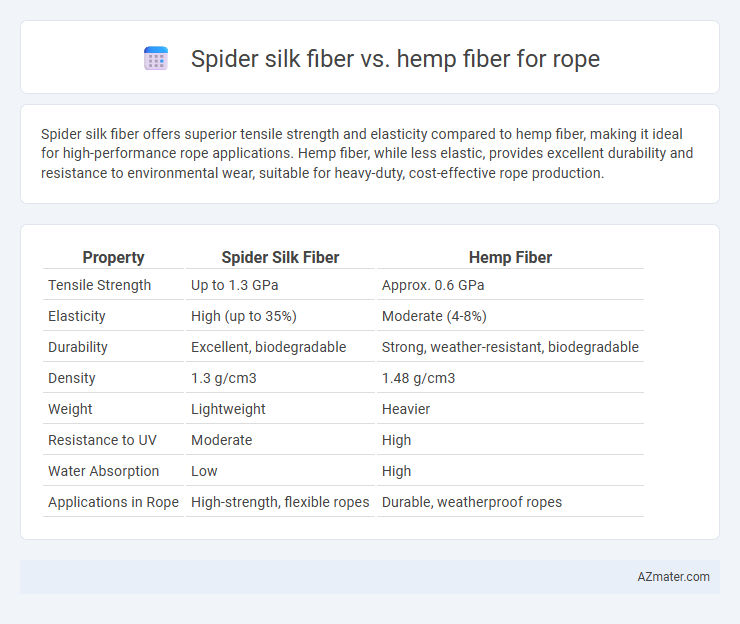Spider silk fiber offers superior tensile strength and elasticity compared to hemp fiber, making it ideal for high-performance rope applications. Hemp fiber, while less elastic, provides excellent durability and resistance to environmental wear, suitable for heavy-duty, cost-effective rope production.
Table of Comparison
| Property | Spider Silk Fiber | Hemp Fiber |
|---|---|---|
| Tensile Strength | Up to 1.3 GPa | Approx. 0.6 GPa |
| Elasticity | High (up to 35%) | Moderate (4-8%) |
| Durability | Excellent, biodegradable | Strong, weather-resistant, biodegradable |
| Density | 1.3 g/cm3 | 1.48 g/cm3 |
| Weight | Lightweight | Heavier |
| Resistance to UV | Moderate | High |
| Water Absorption | Low | High |
| Applications in Rope | High-strength, flexible ropes | Durable, weatherproof ropes |
Introduction to Rope Materials: Spider Silk vs. Hemp
Spider silk fiber exhibits exceptional tensile strength and elasticity, making it a superior choice for high-performance ropes requiring durability and flexibility. Hemp fiber, known for its natural resistance to abrasion and moisture, provides a sustainable and cost-effective option widely used in traditional rope manufacturing. Comparing these materials highlights spider silk's advanced mechanical properties against hemp's environmental benefits and accessibility.
Historical Use of Spider Silk and Hemp Fibers
Spider silk has been historically prized for its exceptional tensile strength and elasticity, with ancient cultures in China and Madagascar utilizing it for fine fishing lines and wound dressings. Hemp fibers, traced back to at least 8000 BCE in Asia, have been extensively used for durable ropes and textiles due to their coarse texture and resistance to rot. Both materials played crucial roles in maritime and agricultural societies, but hemp's ease of cultivation and processing ensured its dominance in rope-making across history.
Production and Harvesting Methods
Spider silk fiber is produced through the biomimetic synthesis of spidroin proteins, a process still limited in scalability due to challenges in farming spiders and replicating their silk gland mechanisms. In contrast, hemp fiber is harvested from the stalks of the Cannabis sativa plant through mechanical retting and decortication, enabling large-scale, cost-effective production with established agricultural infrastructure. The labor-intensive and low-yield nature of spider silk extraction restricts its industrial rope applications, whereas hemp's robust cultivation and efficient fiber extraction methods support widespread use in rope manufacturing.
Mechanical Strength and Durability Comparison
Spider silk fiber exhibits exceptional tensile strength, surpassing many natural fibers including hemp, with a tensile strength ranging between 1.1 to 1.5 GPa compared to hemp's average 0.6 GPa. Its remarkable elasticity combined with strong intermolecular bonding results in superior resistance to mechanical stress and fatigue, making it highly durable for rope applications. Hemp fibers, while durable and resistant to environmental factors like UV exposure and moisture, generally lack the tensile strength and flexibility found in spider silk, which limits its performance under extreme mechanical loads.
Flexibility and Elasticity: Which Fiber Performs Better?
Spider silk fiber exhibits superior elasticity and flexibility compared to hemp fiber, making it ideal for applications requiring high stretch and resilience. Its unique protein structure allows it to stretch up to five times its original length without breaking, while hemp fiber is relatively stiff with limited stretch capacity. For ropes that demand both durability and dynamic performance, spider silk significantly outperforms hemp fiber in flexibility and elasticity.
Environmental Sustainability and Ecological Impact
Spider silk fiber offers exceptional strength and biodegradability, making it a sustainable alternative for rope production with minimal environmental footprint. Hemp fiber is highly renewable, requiring low water and pesticide use, and contributes to soil health through carbon sequestration, enhancing its ecological benefits. Both fibers support eco-friendly rope manufacturing, with spider silk excelling in biodegradability and hemp in resource-efficient cultivation.
Cost and Availability of Spider Silk and Hemp
Spider silk fiber remains prohibitively expensive and scarce due to the complexities of harvesting from spiders and limited synthetic production capabilities, making it impractical for widespread rope manufacturing. Hemp fiber is widely available, affordable, and easily cultivated in various climates, offering a cost-effective and sustainable alternative for rope production. The lower market price and abundant supply of hemp fiber contrast sharply with the high production costs and limited accessibility of spider silk.
Practical Applications in Rope Manufacturing
Spider silk fiber offers exceptional tensile strength and elasticity, making it ideal for high-performance ropes used in climbing and rescue operations where durability and flexibility are critical. Hemp fiber excels in abrasion resistance and environmental sustainability, commonly utilized in marine and agricultural ropes for its natural rot resistance and biodegradability. Rope manufacturers increasingly explore spider silk blends to enhance strength without compromising hemp's cost-effectiveness and ecological benefits.
Limitations and Challenges for Each Fiber
Spider silk fiber exhibits exceptional tensile strength and elasticity but faces significant limitations in large-scale production due to difficulties in farming spiders and high synthetic replication costs. Hemp fiber, while more readily available and cost-effective with good durability and resistance to UV light, suffers from lower elasticity and susceptibility to mildew without proper treatment. Both fibers require advancements in processing technology to overcome scalability and environmental durability challenges for rope manufacturing.
Future Prospects and Innovations in Rope Technology
Spider silk fiber offers unmatched tensile strength and elasticity compared to hemp fiber, making it a prime candidate for developing ultra-lightweight, high-performance ropes in the future. Innovations in bioengineering have enabled the scalable production of synthetic spider silk, promising sustainable and eco-friendly alternatives that outperform traditional hemp ropes in durability and flexibility. Future rope technology will likely integrate spider silk composites with hemp fibers to enhance cost-effectiveness while maintaining superior mechanical properties for industrial and medical applications.

Infographic: Spider silk fiber vs Hemp fiber for Rope
 azmater.com
azmater.com